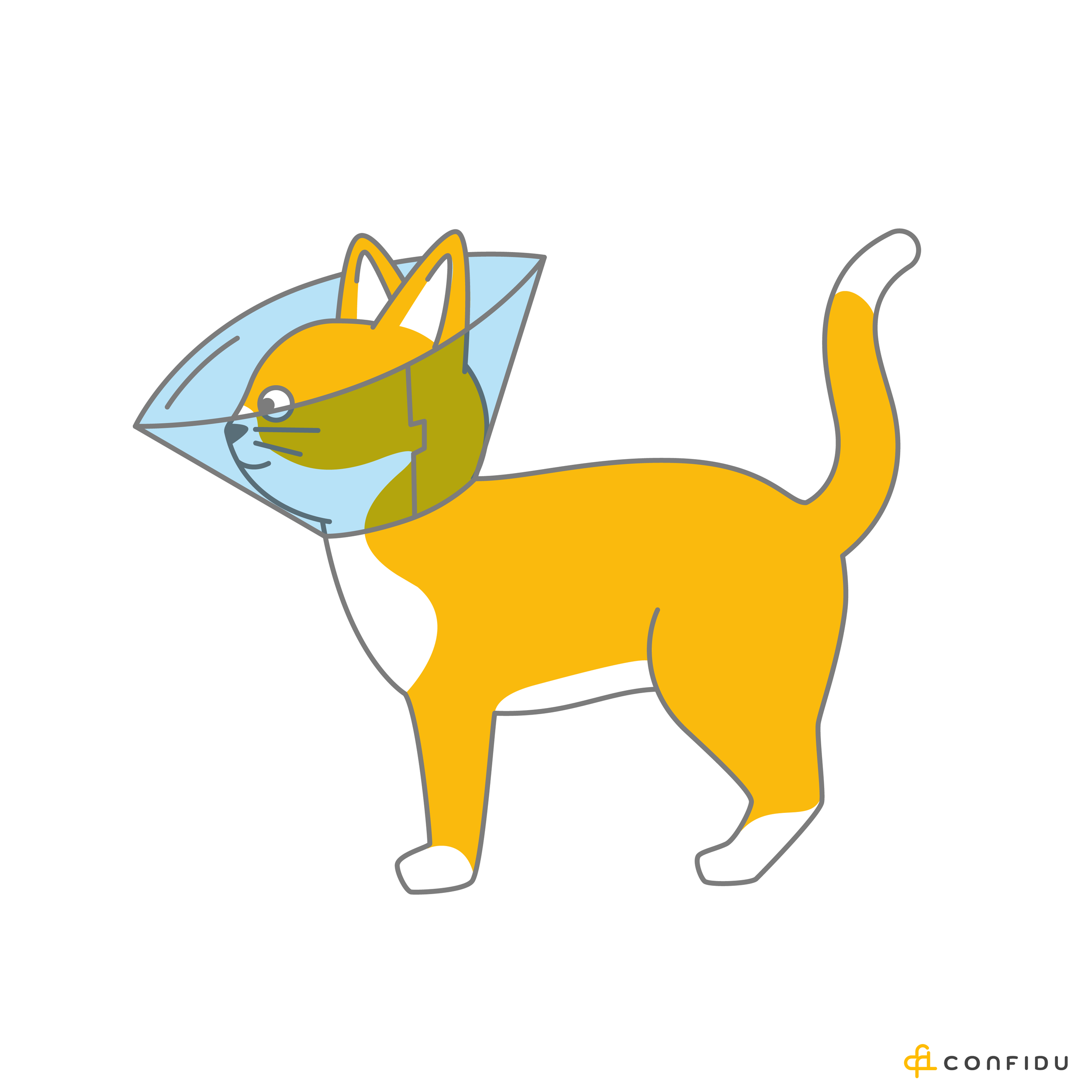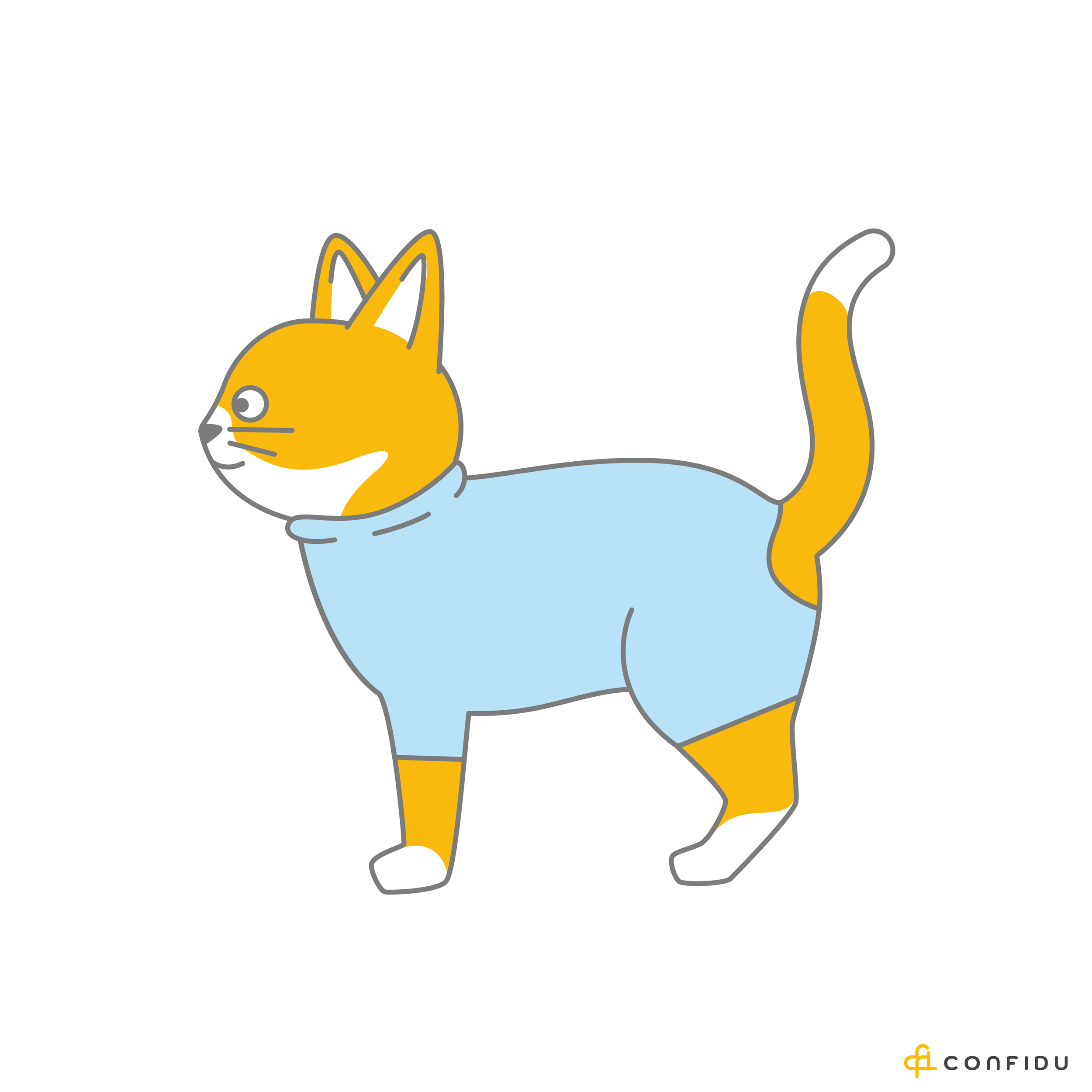cover: Ivan Yerokhin | Unsplash
Collar for cats. Sometimes it is necessary for your cat to wear an Elizabethan collar to prevent scratching or licking. However, the cat probably won't be too happy about it at first. In this article, we explain why it is important to keep the collar on your cat and how you can make it easier for your cat. We also look at the advantages and disadvantages of alternatives to the classic collar.
How long does the cat have to wear the collar?
How long your cat has to wear a collar depends on the reason why it needs to be worn. If the collar has been ordered by a vet, the rule is very simple: the collar comes off when the vet gives the green light. This is because he/she knows best how long the collar will be needed to protect your cat from secondary problems caused by licking or scratching, surgical wounds, inflamed eyes or ears. Do not hesitate to ask if you are unsure about the timing. Your vet will be able to give you more information.
If you remove the collar too early, your cat may injure itself so badly that emergency surgery is necessary. Cats have been known to open abdominal wounds. Even if you trust your cat and believe that it won't lick the wound, unfortunately there is never a guarantee. In addition, sore eyes or ears may not heal properly due to scratching and may be damaged. If your cat has a strong urge to scratch its ears or eyes despite the collar, it is probably in pain and should be given a painkiller.
How does the collar fit correctly?
To keep the Elizabethan collar in place, it must be secured to the neck with a neckband, a piece of gauze bandage or something similar. Make sure that it is not too tight and not too loose. There should be about one to two finger widths of space between the skin and the neckband, depending on the size of the cat. This is the only way the band won't choke your cat, but the collar can't simply be slipped over the head either.
The neckband is also the reason why outdoor cats are not allowed outside until the collar can be removed. This is usually a challenge for both humans and animals, but would be far too dangerous for the cat. There is a risk that it could get stuck with the collar and strangle itself. If your outdoor cat can't stand being indoors, you may want to choose an alternative such as a collar. But even this is not risk-free and cannot be applied to all problems.
Cat with classic Elizabethan plastic collar
image: ANUCHID.L | Shutterstock
Can a cat eat with a collar?
Yes, it can. However, you can help her to make eating a little more comfortable. Small, flat plates may be more appropriate than bowls to make it easier to reach the food. Place them in accessible places and perhaps use a non-slip base. Otherwise, your cat may push the bowls around or tip them over because they are hard to reach or slippery.
If your cat has eaten with the collar, you should always check for food residue on the cone and clean it if necessary. Otherwise the collar will quickly become a smelly burden for you and your cat. This is also why plastic collars are better than alternative fabric collars: they are easier to clean.
Alternatives to the classic collar: What can I do to stop my cat licking his wound?
If your cat doesn't like a classic collar, for example because it makes loud noises when it bumps into something, there are now several alternatives. However, from a veterinary point of view, the plastic collar is the safest option to stop your cat licking or scratching. It shields the head safely, is easy to clean and is stable. All the alternatives have disadvantages. So consider carefully which collar is best for your cat and your problem. If in doubt, try several methods.
Soft cat collar
The Comfy Cone is an alternative to the classic plastic collar. It has the shape of a classic cone, but is made from a soft material. The advantages are that lying down and sleeping is more comfortable for your cat. Also, the soft collar will not make a loud noise if your cat bumps into things. The disadvantages are that the soft collar restricts your cat's view. It is also less stable and some cats manage to fold the collar over. This allows them to reach their rear end and paws with their tongue.
Inflatable collars
There are inflatable collars that can also be worn around the neck. They are designed to restrict your cat's movement when attempting to lick its chest and back. The advantages are that your cat will be able to eat and drink more easily and its vision will not be restricted. The disadvantages are that the collar does not necessarily prevent your cat from scratching its head and your cat can reach its rear end and paws with its tongue. Depending on the quality, inflatable collars can also break easily and some have a strong odour, which can irritate your cat. The collar can also get in the way when your cat is lying down.
Ring collar or circular cone
Another option is a ring collar to prevent licking. There are functional ones that are single-coloured and made of easy-to-clean material, like Tepaw's. Then there are colourful ones that make your cat look cuter. However, we strongly advise against these collars as they are often of poor quality, unstable and difficult to clean. The advantages are that the ring collar does not cover the head and is soft and lightweight. It does not restrict vision, eating or drinking. It protects the whole body and head from scratching and licking. The disadvantages are that the cat has to get used to lying with the collar on. Also, cats can try to fold the collar backwards to reach their paws and rear end.
Neck brace
An alternative to the classic collar is the neck brace. It restricts the movement of the neck and head so that your cat is unable to lick itself. The advantage is that the neck brace does not cover the head. It does not interfere with eating or drinking and does not restrict vision. The disadvantages are that the neck brace is only suitable for protecting wounds after abdominal surgery.
Cat bodysuit
If you don't want to put a collar on your cat, the cat bodysuit is an alternative. Like a baby's romper suit, it covers the body but leaves the head, rump, legs and tail exposed. The bodysuit protects wounds on the body from licking, for example after surgery such as neutering. It is best to put it on your cat during the surgery as it is unlikely to tolerate being dressed when it is awake. The advantages are that the bodysuit does not hinder eating, drinking or lying down. It also does not restrict vision or make noise. The disadvantages are that it cannot be used for every injury or wound, and it does not protect against scratching. Also, many cats are not enthusiastic about the clothing and need time to get used to it. It is therefore important that the cat bodysuit is the right size and fits well. Otherwise, the cat can easily wriggle out of the bodysuit and it will be difficult to get it back on.
Can the collar be dangerous?
Collars are not dangerous to cats. This means that cats cannot hurt themselves while wearing them.
The problem is that the cone or its alternatives are unfamiliar to the cat and often cause defensive behaviour. The collar restricts the cat's movement slightly and sometimes makes frightening noises. But even if the cat tries to remove the collar, you should not remove it. Without the collar, the injuries the cat can inflict on itself are much worse. It is possible for surgical wounds to reopen and require further surgery to close them.
To make wearing the collar more comfortable for your cat, you should give it lots of cuddles. You can also use so-called feel-good hormones, which calm cats down. One example is Feliway®, which is plugged into a socket and releases pheromones into the air through a vaporiser.
Can I get my cat used to the collar?
If you know that your cat will need a collar soon, you can practise wearing it with your cat. Put the collar on for a few minutes every day for a week. Let your cat explore and smell the collar in the beginning. Use treats as an encouragement to keep it in place so you can put the collar on. It will also give your cat a positive association with the collar.
Use a cat teaser wand to guide your cat through everyday situations that could cause problems, such as between chairs, up and down stairs, etc. This will teach her to move with the collar. Put the collar on her at mealtimes so she learns to eat with it. Reward it afterwards with treats or cuddles, whichever it prefers.
Cat with bodysuit
image: MabelAmber | Pixabay
Where can I buy collars?
Cat collars are available from online retailers and pet shops. You can also buy cat bodies there. Prices vary widely, from classic hard plastic collars costing a few euros to more elaborate models costing up to €30.
When buying, make sure you get the right size for your cat. If the collar or body is too small, it will not close. If they are too large, your cat will easily get out of them.
We recommend not throwing away used collars and always having a spare one at home. Also, practice carrying the collar with your cat regularly. This way, if your cat is injured or has eye or ear problems, you can put the collar on it before going to the vet. This will prevent it from aggravating the problem by scratching or licking. Also, your cat will probably be fitted with a collar at the vet anyway, so you'll have yours with you.
Conclusion
Elizabethan collars are useful and protect your cat from self-harm. There are many different models to choose from, so research the pros and cons before making your choice. The one you choose should always be sturdy and easy to clean. Practise wearing the collar with your cat and reward it to get it used to it quickly.
The confidu magazine is written by our veterinarians according to current scientific standards. The articles do not replace a veterinary diagnosis, but are intended to provide you with initial information on many topics related to your animal. If you have specific questions about your pet, our vets will be happy to advise you via the confidu app.













